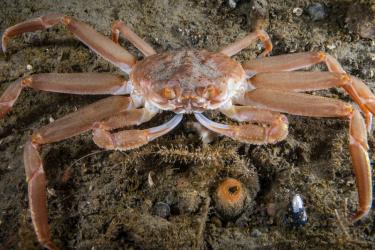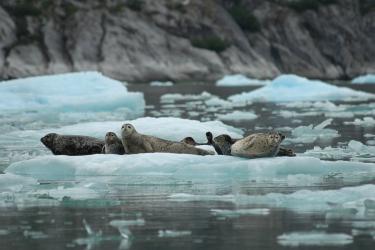Biology

Northern rock sole (Lepidopsetta polyxystra) is a flatfish species commonly encountered in the eastern Bering Sea. Its range extends from Puget Sound, Washington, through the Bering Sea and Aleutian Islands to the Kuril Islands. This species is distinguished from its congener, the southern rock sole (L. bilineata), through comparison of gillraker and supraorbital pore counts (Orr and Matarese, 2000).
Flatfish stocks in the waters of the eastern Bering Sea’s continental shelf have dramatically increased in abundance since the 1970s, and in particular, northern rock sole stock biomass increased 15-fold between 1975 and 1994 (Walters and Wilderbuer, 2000). This species is a valuable target of trawl fisheries in the Bering Sea, especially the roe fishery, with an average annual catch of 48,175 metric tons between 1989 and 2005 (Wilderbuer and Nichol, 2006).

Northern rock sole spawn in winter through spring, producing demersal egg masses that adhere to benthic substrates (Stark and Somerton, 2002). Larvae are pelagic and are most commonly found over depths of less than 500 m (Orr and Matarese, 2000). Adults have separate winter spawning and summer feeding distributions (Wilderbuer and Nichol, 2006). Females reach 50% maturity at 328 mm, or about 7 years of age (Stark and Somerton, 2002). Males and females exhibit significant differences in growth, with females generally growing more slowly but to larger sizes than males (Stark and Somerton, 2002). Von Bertalanffy growth parameters for northern rock sole collected during trawl surveys in the Bering Sea and Aleutian Islands from 2005-2007 were L∞=333.1 mm, k=0.2474/yr, and t0=0.984 yr for males and L∞=400.7 mm, k=0.1704/yr, and t0=0.590 yr for females (Fig. 1).
Age Determination History


Lepidopsetta species have been aged on a production basis at the Alaska Fisheries Science Center since 1971, although age records have only distinguished between northern and southern rock sole since 1996; prior to that time they were believed to be a single species. Otoliths are aged primarily using the break-and-burn method, although surface readings are made when possible (Table 1). (Please see Goetz et al., 2012, for a more detailed description of standard AFSC otolith preparation methods.)


Age determination of northern rock sole is relatively simple, and inter-reader agreement tends to be high (Table 1). The maximum age reported by the AFSC Age and Growth Program for northern rock sole is 28 years (Table 1). Age estimates for this species have been corroborated by edge analysis (Kimura et al., 2007) and synchronous growth patterns shared among individuals (Matta et al., 2010).
Current Age Determination Methods
For young fish (<8 years) it is sometimes possible to determine age solely from the otolith surface (Fig. 2). The otolith is read from the core to the edge under a dissecting microscope with reflected light from a fiber optic light source (Fig. 3). Each year of growth typically consists of one opaque (light) and one translucent (dark) growth zone. In general, each translucent growth zone is equivalent to an annual mark and should be counted if it extends around the circumference of the otolith. Surface examination should only be attempted by experienced age readers when the growth pattern is clear.

For older fish and otoliths with vague surface patterns, the break-and-burn technique is necessary. Starting at the core, each translucent growth zone is counted reading out toward the edge. It is best to examine multiple reading axes to obtain a precise age estimate (Fig. 4). If age estimates differ among reading axes, the final age estimate is assigned using the clearest axis.
Translucent growth zones should only be counted if they extend around the circumference of the otolith (Fig. 5). Checks are sometimes present and can usually be distinguished from annual marks, as they are fainter and do not extend around the entire circumference of the otolith. Occasionally splitting, where a single annual mark is made up of two or more translucent growth zones, also occurs. Split growth zones can be identified in much the same way as checks, as they typically do not extend around the circumference of the otolith (Fig. 6). Some northern rock sole otoliths also have constricted (i.e., closely spaced) annual marks (Fig. 7).

Literature Cited
- Goetz, B. J., C. E. Piston, C. E. Hutchinson, C. G. Johnston, and M. E. Matta. 2012. Collection and preparation of otoliths for age determination. In Age determination manual of the Alaska Fisheries Science Center Age and Growth Program (M. E. Matta and D. K. Kimura, eds.), Chapter 3. NOAA Professional Paper NMFS 13.
- Kimura, D. K., D. M. Anderl, and B. J. Goetz. 2007. Seasonal marginal growth on otoliths of seven Alaska groundfish species support the existence of annual patterns. Alaska Fish. Res. Bull. 12(2):243-251.
- Matta, M. E., B. A. Black, and T. K. Wilderbuer. 2010. Climate-driven synchrony in otolith growth increment chronologies for three Bering Sea flatfish species. Mar. Ecol. Prog. Ser. 413:137– 145.
- Orr, J. W., and A. C. Matarese. 2000. Revision of the genus Lepidopsetta Gill, 1862 (Teleostei: Pleuronectidae) based on larval and adult morphology, with a description of a new species from the North Pacific Ocean and Bering Sea. Fish. Bull. 98:539-582.
- Stark, J. W., and D. A. Somerton. 2002. Maturation, spawning and growth of rock soles off Kodiak Island in the Gulf of Alaska. J. Fish Biol. 61:417-431.
- Walters, G. E., and T. K. Wilderbuer. 2000. Decreasing length at age in a rapidly expanding population of northern rock sole in the eastern Bering Sea and its effect on management advice. J. Sea Res. 44:17-26.
- Wilderbuer, T. K., and D. G. Nichol. 2006. Northern rock sole. In Stock assessment and fishery evaluation report for groundfish resources of the Bering Sea/Aleutian Islands region. North Pac. Fish. Mgmt. Council, Anchorage, AK, Section 7:591-652.
Additional Resources
- Alaska Plaice (Pleuronectes Quadrituberculatus) Age and Growth Research
- Flathead Sole (Hippoglossoides Elassodon) Age and Growth Research
- Giant Grenadier (Albatrossia Pectoralis) Age and Growth Research
- Great Sculpin (Myoxocephalus Polyacanthocephalus) Age and Growth Research
- Arctic Cod (Boreogadus Saida) Age and Growth Research


